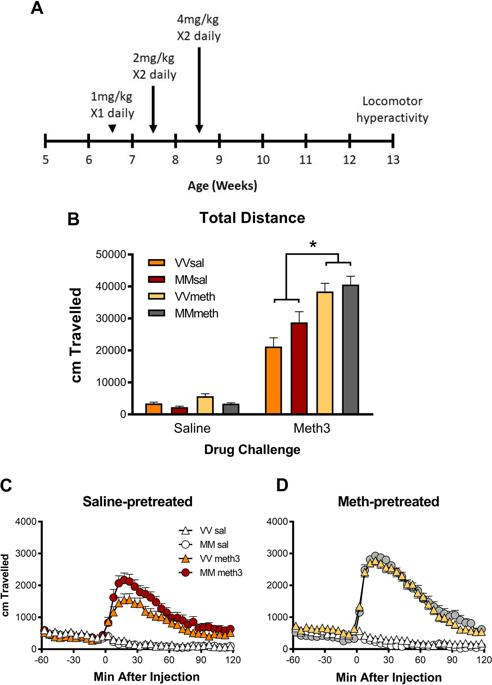Molecular Psychiatry ( IF 11.0 ) Pub Date : 2019-12-10 , DOI: 10.1038/s41380-019-0617-8 David W Greening 1, 2 , Michael Notaras 3 , Maoshan Chen 4 , Rong Xu 2 , Joel D Smith 5 , Lesley Cheng 2 , Richard J Simpson 2 , Andrew F Hill 2 , Maarten van den Buuse 6, 7, 8

|
Methamphetamine (Meth) abuse has reached epidemic proportions in many countries and can induce psychotic episodes mimicking the clinical profile of schizophrenia. Brain-derived neurotrophic factor (BDNF) is implicated in both Meth effects and schizophrenia. We therefore studied the long-term effects of chronic Meth exposure in transgenic mice engineered to harbor the human BDNFVal66Met polymorphism expressed via endogenous mouse promoters. These mice were chronically treated with an escalating Meth regime during late adolescence. At least 4 weeks later, all hBDNFVal66Met Meth-treated mice exhibited sensitization confirming persistent behavioral effects of Meth. We used high-resolution quantitative mass spectrometry-based proteomics to biochemically map the long-term effects of Meth within the brain, resulting in the unbiased detection of 4808 proteins across the mesocorticolimbic circuitry. Meth differentially altered dopamine signaling markers (e.g., Dat, Comt, and Th) between hBDNFVal/Val and hBDNFMet/Met mice, implicating involvement of BDNF in Meth-induced reprogramming of the mesolimbic proteome. Targeted analysis of 336 schizophrenia-risk genes, as well as 82 growth factor cascade markers, similarly revealed that hBDNFVal66Met genotype gated the recruitment of these factors by Meth in a region-specific manner. Cumulatively, these data represent the first comprehensive analysis of the long-term effects of chronic Meth exposure within the mesocorticolimbic circuitry. In addition, these data reveal that long-term Meth-induced brain changes are strongly dependent upon BDNF genetic variation, illustrating how drug-induced psychosis may be modulated at the molecular level by a single genetic locus.
中文翻译:

慢性甲基苯丙胺与 BDNF Val66Met 相互作用重塑中脑边缘蛋白质组中的精神病通路
甲基苯丙胺 (Meth) 滥用在许多国家已达到流行程度,并且可诱发模仿精神分裂症临床特征的精神病发作。脑源性神经营养因子 (BDNF) 与冰毒效应和精神分裂症有关。因此,我们研究了转基因小鼠长期暴露于甲基苯丙胺的长期影响,该小鼠被改造为具有通过内源性小鼠启动子表达的人类 BDNF Val66Met多态性。这些老鼠在青春期后期接受了不断升级的冰毒治疗。至少 4 周后,所有 hBDNF Val66Met甲基苯丙胺治疗的小鼠表现出致敏作用,证实了甲基苯丙胺的持续行为影响。我们使用基于高分辨率定量质谱的蛋白质组学来生化地绘制冰毒在大脑中的长期影响,从而在中脑边缘电路中无偏地检测 4808 种蛋白质。Meth 在 hBDNF Val/Val和 hBDNF Met/Met小鼠之间差异改变了多巴胺信号标志物(例如,Dat、Comt 和 Th),这表明 BDNF 参与了 Meth 诱导的中脑边缘蛋白质组重编程。对 336 个精神分裂症风险基因以及 82 个生长因子级联标志物的靶向分析同样揭示了 hBDNF Val66Met基因型以特定区域的方式控制了 Meth 对这些因子的招募。累积起来,这些数据代表了对慢性冰毒暴露在中脑边缘回路内的长期影响的首次综合分析。此外,这些数据表明,长期甲基苯丙胺诱导的大脑变化强烈依赖于 BDNF 遗传变异,说明药物诱导的精神病如何在分子水平上通过单个基因位点进行调节。


























 京公网安备 11010802027423号
京公网安备 11010802027423号